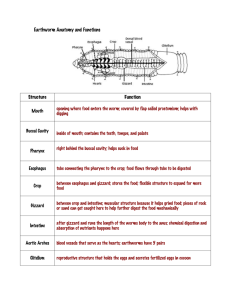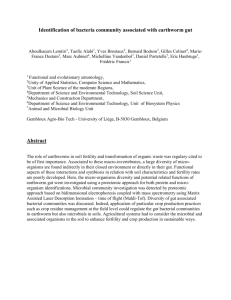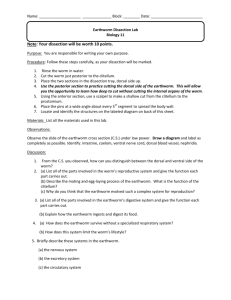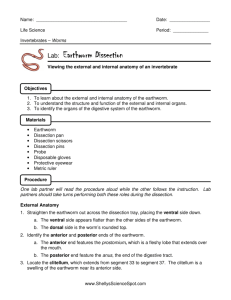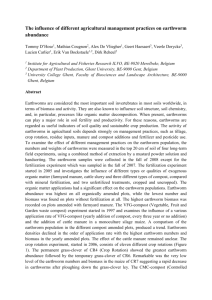Earthworm Dissection
advertisement
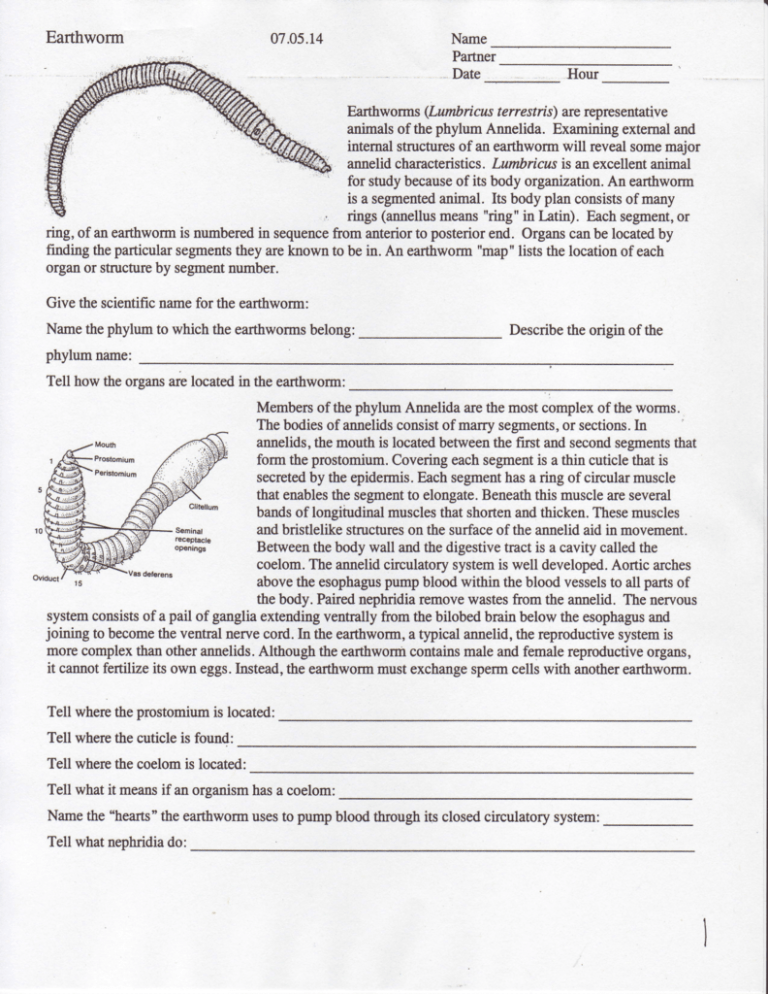
Earthworm
07.05.14
Name
Partner
Date
Hour
Earthworms(Lumbricusterrestris) arerepresentative
animalsof thephylumAnnelida. Examiningexternaland
internalstructuresof an earthwormwill revealsomemajor
annelidcharacteristics.
Lumbricusis an excellentanimal
for studybecauseof its body organization.An earthworm
is a segmented
animal. Its body plan consistsof many
(annellus
rings
means"ring" in Latin). Eachsegment,or
ring, of anearthwormis numberedin sequence
from anteriorto posteriorend. Organscanbe locatedby
finding theparticularsegments
they areknownto be in. An earthworm"map"lists the locationof each
organor structureby segmentnumber.
Give the scientificnamefor the earthworm:
Namethephylumto which the earthwormsbelong:
Describethe origin of the
phylumnirme:
Tell how the organsare locatedin the earthworm:
Membersof thephylumAnnelidaarethe mostcomplexof theworms.
Thebodiesof annelidsconsistof marrysegments,
or sections.In
annelids,themouthis locatedbetweenthe fust andsecondsegments
that
form the prostomium.Coveringeachsegmentis a thin cuticlethat is
secretedby the epidermis.Eachsegmenthasa ring of circularmuscle
that enablesthe segmentto elongate.Beneaththis muscleareseveral
bandsof longitudinalmusclesthat shortenandthicken.Thesemuscles
andbristlelikestructureson the surfaceof the annelidaid in movement.
Betweenthe body wall andthe digestivetract is a cavity calledthe
coelom.The annelidcirculatorysystemis well developed.Aortic arches
pumpbloodwithin the blood vesselsto all partsof
abovethe esophagus
the body.Pairednephridiaremovewastesfrom the annelid.Thenervous
systemconsistsof a pail of gangliaextendingventrallyfrom thebilobedbrainbelowthe esophagus
and
joining to becomethe ventralnervecord.In the earthworm,a typical annelid,the reproductivesystemis
morecomplexthanotherannelids.Althoughthe earthwormcontainsmaleandfemalereproductiveorgans,
it cannotfertilizeits own eggs.Instead,
the earthwormmustexchangespermcellswith anotherearthworm.
Tell wheretheprostomiumis located:
Tell wherethe cuticle is found:
Tell wherethe coelomis located:
Tell whatit meansif an organismhasa coelom:
Namethe "hearts"the earthwormusesto pumpbloodthroughits closedcirculatorysystem:
Tell whatnephridiado:
ExternalAnatomy
Line a waxeddissectingpaqwith a singlesheetof foldednewsprint.
Obtaina preservedearthwormspecirnen,
rinseit thoroughlywith waterto removeexcesspreservative,
and
placeit in thepan.
Locatetheclitellum,a thick bandlocatedaboutone-thirdthe lengthof thebody. The anteriorendis the end
closestto theclitellum,the otherendis theposteriorend. Locatethe anteriorandposteriorendof your
specimen.Also locatethe dorsal(back)andventral(belly) surfacesof the earthworm.Thedorsalsurfaceis
darkerandmoreroundedthan the ventral surface.
How manysegmentsare locatedbetweenthe anteriorend andthe clitellum?
How doesthedorsalsurfaceof the earthwormdiffer from the ventralsurface?
Tagthe following structuresusingdissectingpins andpapertags. (Call your instructorwhenyou havethe
tagsin placesothe locationof eachpart canbe verified. While waiting,you canreadahead,but tagonly
ONE sectionat a time.):
clitellum, anteriorend,posteriorend,dorsalsurface,ventralsurface.verified
Gentlyrub your fingeroverthe ventralsurfaceandalongthe sidesof the earthworm.Rub from theposterior
endto theanteriorend. Repeatthe sameprocedurefrom the anteriorendto the posteriorend. The
"sandpaper"
you feel aresharpbristlesarecalledsetae.Eachsegmentof the earthwormhasfour pairsof
setaethatareusedfor tractionin locomotion.If you haveeverseena bird try to pull an earthwormout of
the ground,you havewitnessedthe effectiveness
of the setae-they lock the earthwormin the soil.
How manysetaearelocatedon eachsegment?
Find theprostomium,or lip, which coversthe mouthat the anteriorend.The earthwormusesthis lip asa
bettering-ram
asit makesa tunneltbroughthe soil. At theposteriorendof the earthworm,locate
the anus.
The earthwormis unusualin that the "food" (soil) that goesin the mouthis actuallycleanerthenit comes
out of the anus. "Difiy soil" goesin, "cleansoil" comesout-the earthwormdigestsusablematerialin the
process.
Many structuresin the earthworrncanbe locatedby countingsegments.Countingstartsat the anteriorend
with segment1. (Seethe diagrambelow.) Usea handlensto locatethe following structures:the openings
to the seminalreceptacles
in segments9 and 10;theopeningsto the oviductsin segment14;andthe
openings
to thespermductsin segment15.
On the figurebelow,labelthe following structures:anteriorend,posteriorend,segments,
setae,clitellurn,
prostorniurn,mouth,anusandopeningsto the seminalreceptacles,
oviducts,andspermducts.
Tag eachof thesestructureson your earthworm:prostomium,anus,locationof the setae,location
of the
externalreproductivestructures
verified
pr oS\o trrrul6
Vas deferens
Goodartistsaregoodobservers!Try your handat beinga goodobserverby drawingyour earthwormin the
spacebelow. Put asmuchdetailinto your drawingasyou can. The diagramabovemight be of somehelpif
this is newto you.
Onceyou havecompletedyour drawing,labeltheprostomium,clitellum,andanus.
Placeyourearthwormon thestageof a stereoscope.
with someobservable
Locatesomssegments
setae.
Usethecirclebelowasa field of view anddrawseveralof tlresegments
showingthe setas.Don't forgetto
add your magnification.
X
InternalAnatomy
Placetheearthworm
in thedissecting
panwith its dorsalsurfaceup.
Stretchouttheearttrwormand,with dissectingpins,pin both endsto thebottomof thepan.
(A helpdiagramis foundon thp nextpageof this gufule It will helpyou thruughthe rtepsbelow.
Studythe diagrambeforeyou beginthe dissection!)
ksert a bladeof thescissorsat theposteriorendof theearthwormandslightlyto theright of ttredorsal
bloodvessel.Thisbloodvesselruruundertheskinfromoneendof theearthwonn
to theother.Cutalong
thedorsalsurfacefrom theposteriorendto theanteriorendof theearthworm.Note: Only a shallowcut is
n€ces$aty
because
the skin and muscksof the earthwormare vely thin. Keepthe sclssorsunderthe
skinand parallelto the bottomof the pan.
Afterevery10to 15segments,
gentlyfoldbackthebodywall on eithersideandpin it to thepan. Placethe
pinsat 15oanglessotheywill notinterferewith yourobservations.
Notp:As youcontinuethis
investigation,
periodically
bathetheearthworm
with a few dropsof waterfroma dropperto preventthe
earthwormfrom dryingout.
As you cut noticetheseptqor thinmembranes,
thatseparate
eachsegment.Carefullycuttlroughthesepta
to separate
theinternalorgansfrontthebodywall. Theinternalorgansof theearthworm(andyou,for that
fact)arelocatedin a largebodycavitycalledthecoelom.
Theearthwormhasa truecoelom.Whatdoesthatmean?
Verified
F.C.
q
Posterior
A. Placewormin tray,dorsalsideup. pin
throughanteriorand posteriorsegment
B. Liftskinwith forceps.Withscissorscut
throughskin (otfcenter)to the anus.
Do not damageinternalorgans.
c. Withscalpelor tazo(,cut throughsepta
on bothsidesof intestine,pin bodvwall
to tray as shown.
/
D
Cut throughclitellumtowardanteriorend.
Severseptaand pin as shownin E.
Seminalvesicles
HELf
Dorsal blood vessel
Gizzard
Suprapharyngeal
n
tr I 12
Buccal
cavity
rsl
rnl
\15
16
17
Testis
oulrv I oviduct
Lateral
EsoPhageal
seminai
nerves
Vas deferens
iecepiactes"st"nos" seminal
Ventral
ventral nerve cord
receptacle
blood vessel
/
of
Gangtla
Suprapharyngeal
ganglion
Seminalreceptacle
Esophageal"glands,'
Testis
Anteriorspermfunnel
Ovary
Posterior
spermfunnel
Vas deferens
Egg funnel
.. Oviduct
Seminalvesicles
septum
Malegenitalpore
Femalegenital
Ventralnervecord
Nephridium
Segmentalganglion
DigestiveSystem
Locatethe mouth (alsocalledthe buccalcavity) on the ventralsideof segment1.
Follow the path of the digestivesystemby locatingthe pharynxin segments2 through6, the esophagus
in
segments7 through 14,the crop in segments15 and 16,the gizzardinsegments18 and 19,andtle iitestine
in segments20 to the anus.
The earthwormhasa tube-within-a-tubebody structure.The innertube is the digestivetract.
Food,in this case"dirty dirt" (soil with lots of organicmatter),is takenin by the mouth. The prostomium
(the lip on the anteriorendthat is usedlike a batteringram asthe earthwormmovesthroughthe soil) moves
to the sideto allow the soil to enterthemouth.
The foodpassesinto thepharynx,thewidenedtubebehindthemouth. You alsohavea pharynx.....When
you standat a mirror andopenyour mouthwide (go ah-h-h-h)thepharynxis the areayou seeat the backof
your throat.
From there,food travelsdown the narow esophagus
to the crop. (In humans,the fodd alsotravelsdown the
esophagus
but it landsin the stomach.)The crop is a large,thin-walledstoragebag-chickens alsohavea
crop.
Justbelow the crop is the gizzard,a muscularstructurethat grindsthe food. Chickensalsohave gizzards
that areusedfor grindingfood. Ifyou haveevereatena chicken gizzardyouknow how thick, toirgh,and
muscularit is. Earthwormsandchickensusethe gizzardtogrind their food sincethey don't haveGeth.
(Now you know why your mom wantsyou to chewyour food-you don't havea gizzard,,)
The food is then digestedin the narrow intestine,which continuesto the posteriorendof the earthworm.
Any undigested
food is removedthroughthe anus.An interestingasideon earthwormdigestion....
Earthwormseat"dirty dirt" anddigestthe organicmaterialfor their use. Becauseof that,the materialthat
leavesthe anusis technicallycleanerthanwhat goesin the mouth. The leftovermaterialshouldn'tbe called
"cleandirt" becausethereis still undigestedorganicmaterialin it but it is interestingto notethat what goes
in the earthworm'smouth is dirtier thanwhat comesout the anus.
Give an alternatenamefor the mouth.
What doesa "tube-within-a-tube"meanwhenreferringto the earthworm'sbody structure?
why is the food that entersthe earthworm'smouthcalled"dirh, dirt"?
Tell whattheprostomiumdoes.
What is the functionof the esophagus?
What is the functionof the crop?
What is the functionof the gizzard?
How do the crop and gizzardwork with eachother?
What is the purposeof the intestine?
Tell why (technically)the materialenteringthe mouth of an earthwormis dirtier that what leavesthe
anus.
l
On the figurebelow,labelthe following structures:mouthpharynx,esophagus,
crop,gizzard,andintestine.
(Hint: Usethe segmentnumbersasa guidefor locatingthe organs.)
Tagthe following: pharynx,esophagus,
crop,gazud. intestine.
Completed
Cut into the intestines.Usea probeto removea sampleof the digestedfood andplaceit in a dropof water
on a microscopeslide. Add a coverslip andview underthe compoundmicroscope.Draw a sampleof what
you observein the spacebelow. kave your slidein placeandlet your instructorverify whatyou haveseen.
x magnification
Verified
Respiratory System
The earthwormhasno specializedorganssuchaslungsor gills to takein oxygen. Instead,oxygendiffuses
throughits skin into its blood. The skin mustbe moist for oxygento moveacrossthe cell membranes-if
the skin dries,theearthwormwill suffocate.Sincethe skin is the organof respirationin the earthwormthere
areno otherorgansto locatefor this system.
Explainhow respirationtakesplacethroughthe skin.
What happensto an earthwormif its skin dries out?
What happensto an earthworm,aftera big rain, whenthe soil is flooded?
)
Muscular System
The skin alsocontainsmuscles.Justinsidethe bodywall arethe circularmuscles,which go aroundeach
segment.Underthesearethe longitudinalmuscles.Whenthe circularmusclescontract,they squeeze
the
longitudinalmuscles,muchlike a handsqueezingtoothpasteout of a tube. The squeezingelongates
the
longitudinalmuscles,which thencontractto shortenthe worm. The actionof thesetwo setsof muscles,
togetherwith the setae,makesthe earthwonn'slocomotionfar moreefficientthanotherworms.
How doesan earthwormmovethroughthe soil? 1. With thebody shortened,
the earthwormlockshis
posteriorbody setaeinto the wall of the burrow. The anteriorsetaearepulled into the body.
This locksthe
backendso it can't moveandfreesthe front end.2. Theearthwormuseshis musclesto eiongatethebody.
Theprostomiumactsasa batteringram makinga newburrowthroughthe soil. 3. The earthwormthen
lockshis anteriorsetaeinto placeandretractsthe posteriorsetae-this locksthe front endandfreesthe
back
end. 4. He onceagainshortenshis body bringingthe posteriorendforward.
Thoughthe descriptionabovesoundssimple,it is actuallymuchmorecomplicated-just aswith walkingin
you' In reality,the functionof the musclesandsetaeripple throughthebody in a highly organized
manner.
This is all coordinated
by the nervoussystem.
outline the four stagesusedby an earthwormto movethroughthe soil:
l.
2.
3.
4.
Circulatory System
The earthwormhasa closedcirculatorysystem,asdoesthe human. Blood is pumpedaroundthebody in
blood vessels.Thebloodabsorbsdigestedfood from the intestineandoxygenfrom the skin anddelivers
themto bodytissues.
The bloodvesselsextendthe entirelengthof the worm.Thedorsalvesselis the majorpump,movingthe
blood from theposteriorendto the anteriorendof the wonn. You may find this vesselin the skin flap of the
worm on thedorsalsurface.The easiestplaceto locatethevesselis whereit crossesthe crop and,
gazard,.
The ventralvessellies beneaththe organs.The two vesselsareconnectedby five aorticarches(sometimes
called_"hearts"),
which surroundthe esophagus.
The "hearts"may be difficult to seeasthey arelocated
behindtheesophagus.
Namethe type of circulatorysystemfound in both the earthwormand the human:
Give themajorcharacteristic
of this system:
Give the official rulme for earthworm .heafis,,
The earthwormhasa circulatorysystemsuperiorto that of the lower animalsthat you havestudied.
Explain
why this is necessary.
?
Iocate thethin dorsalblood vesselthat extendsthe lengthof the earthworm.
Find the five pairs of aortic archesthat surroundthe esophagusin segments7 through 11.Whenthe
muscularwallsof the archescontract,they act as "hearts"thatpumpblood throughthe earthworm.
Usinga straightteasingneedle,lift up a sectionof the intestinenearthe posteriorendof the earthworm.
locate theventralbloodvesselandthe aorticarchesthatconnectthe dorsalandventralblood vessels.
In the figurebelow,labelthe following pafts:dorsalbloodvessel,aorticarches,andventralbloodvessel.
Tagthe following: blood vessel(your choice,dorsalor ventral),aorticarches
Verified
FlontrndsidEmugfholr cf rn carthnorm,
"l've beentold you dont like my dift!"
ID
NervousSystem
The earthwomthasa ganglionmassthat seryesasits brain.It appearsasa smallwhitemassof tissuejust
abovethepharynx.Thebrainis connectedto the ventralneryecord,which extendsthe lengthof theworm.
To seetheventralnervecord,dissectout a pieceof intestineabout4 cm long. The nervecordappearsasa
white threadalongthe ventralbody wall. You might seethe ventralblood vesselabovethe nervecord.
locate thetwo-lobed"brain"that appearsasa smallmassof white tissuein segment3.
Usinga straightteasingneedle,lift up the pharynxandpart of the esophagus.l,ocatethe white ventral
nervecordthatextendsalongthe ventralsurfaceof the earthwormfrom segment3 to the lastsegment.
Two neryespassaroundthe esophagus
andconnectthe brainto the ventralnervecord.
Locatea smallganglion,or massof nervecells,that is attachedto the ventralneryecordin eachsegment.
Thebrainis actuallytwo slightly largerganglia.
Give the official namefor the earthworm'sbrain.
Namethemajorneryethat extendsthe lengthof the worm.
On thediagrambelow,labelthe ganglionandventralneryecord...
Tagthe following: ganglion,ventralnervecord
Verified
Excretory System
Eachsegmentof the earthwormhasits own organsof excretion-thenephridia.The nephridiaserveassmall
kidneys,removingwasteproductsfrom theblood andbody fluids. The nephridiaappearassmallwhite
coiledtubeson eachsideof the digestivetract,nearthebody walls.You rnayneedto usea handlensto
locatethem.
What is the function of the nephridia?
Usinga straightteasingneedle,lift up the digestivesystemnearthe centerof the earthworm.Locatethe
nephridia,or smallwhite coiledtubes,lyingagainstthe lateralwalls of the earthworm.Usea handlensto
examinethesestructures.The nephridiumopensinto the coelom,runs throughthe body wall, andendsin an
excretorypore. Eachsegmenthasa pair of nephridiaexceptfor the first threesegmentsandthe last
segment.
It
ReproductiveSystem
The earthwormis hermaphroditic--it
hasboth maleandfemalereproductiveorgans.The seminalvesicles;
which storesperm,arethreepairsof white sac-shaped
The
structureson eachsideof the esophagus.
seminalreceptacles,
which receivespermduringmating,aretwo pairsof smallwhite roundstructures
nearthevesicles.Testes,which producesperm,andovaries,whichproduceeggs,lie underthe seminal
vesiclesandwill probablybe difficult to see.
What is the major characteristicof a hermaphrodite?
What is the functionof the seminalvesicles?
What is the functionof the seminalreceotacles?
l-ocatethe seminalvesiclesin segments9 through13of the earthworm.The seminalvesiclesconsistof
threelobeson eithersideof the esophagus.The spermcellsarestoredin theselobesuntil they are
transferredto anotherearthwormduring mating.
In segments
9 and 10,locatethe two pairsof smallseminalreceptacles.Theseorgansreceiveandstore
spermcellsfrom anotherearthwormduringmating.
Usinga handlens,attemptto locatethe two pairsof smalltestesin segments10 and,11 andthe smallpair
of ovariesin segment13.
,
In the diagrambelow,labelthe nephridium,seminalvesicles,seminalreceptacle,
testes,andovaries.
Tagthe locationof anyreproductivegland.
Verified
Earthwormsduring mating:
IZ
How doesthe dorsalsurfaceof an earthwormdiffer from the ventral surface?
Whatdo you febl whenyou run your finger alongthe outsideof thb earthworm?
What doesthe prostomiumdo?
Describetheclitellum:
What is the function of the crop in the digestivesystem?
What is the function of the guzard in the digestivesystem?
Explain:
Is the circulatorysystemof an earthwonnopenor closed?
What aregangliaand wherearethey located?
Comparethe functionof the seminalvesiclesandseminalreceptacles:
"Soy, Anlhony, thls looks llke o pleosont lltile ploce'"
r3
EARTHW@RNfi:
'I
Sl
SEGMENT
NEPHR[D[@P@RE'
F@RE.
SEnfl"REGEPTAGLE
F@RE'
@V[DU@T
SPERnflDUGTP@RE.
M@UTH*
tsUGGALGAVITY
ULBU#JlEr
t{:t | il|t=il
| ililtlvil^
\:/t=u
uvuu
u L=IL=E\:/
PHARVNX,
ESOPHAGUS*
GROP'
GIZZARD*
INTESffiNEo
ANAL F@RE'
/.1
EARTHW@RNfi:
D@RSALVIESSEL
HEART'
GEREBRALGANGLI@NO
D@RSAL
SURFAGR
VENTFOLATEMT
NERVEGORD/
GANGL[@NO
l:
EARTHW@RNflg
GUT[GLE^
EP[DERM[S,
NflUSGLE.
GIRGULAR.
L@NGITUDINALO
SETARETRAGT@R.
GOEL@Mc,,-
LUNfiEN*'
VESSELS.
DORSAL,
L@G@M@T[@N
NERVEG@RDO
NERVE,
SENSE@RGAN.
Y/.
iv

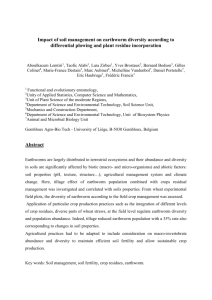
![Earthworm Lab [1/16/2014]](http://s3.studylib.net/store/data/007071636_1-f0a789e538fb90aecda95ecf7b0a3557-300x300.png)
